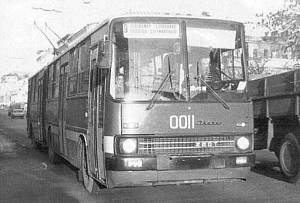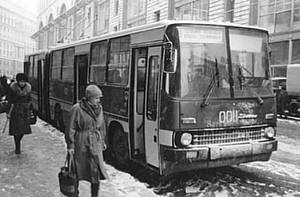|
|
Obus - IK-280 trolleybuses |
|
|
|
|
|
|
|
|
|
|
|
The first trolleybus of the Obus Ltd. - or rather its ancestor in 1987 the BKV Experimental Works (BKV = Budapest Transportation Company) was the 199.The trolleybus 199
The 199 was ready in 1987 (or in 1989). In the ususal IK-280 body a DK 211 type motor (of maximal output 150 kW) was mounted, with different electric regulation as the Budapest ZIU-series. A similar equipment was in the BKV 972 ZIU-9 type trolleybus in its original state. By the acceleration there was no major difference, but by deceleration the exciting-circuit was put on the 24 V battery, while the main circuit was regulated by the starter (in the usual ZIU electrics, the main circuit and the starter do not play a role). This change strengthened the rheostatic brake. However the construction did not operate well: its greatest disadvantage was the increased reaction time, and also somtimes the rehostatic brake blocked the driven axle. Similar equipment was mounted also in the ZIU-9 9-139 of Szeged, there the trolleybus also produced some blockings, which could have caused accidents. Possibly for similar reasons stood more than one year the 972 in the depot after its arrival.
Officially the 199 became the part of the BKV's fleet in 1990. But
even after the trolleybus was not in service many times because of the badly working
electrics - the drivers simply were not content to take the trolleybus in the
traffic. In the end, by 1996 the ZIU-equipment was removed, and a spare set of
GVM electronics and motor was mounted. From this time it carries the number
283, but its external look is still different from the series of GVM at some
parts.
In 1987, two IK-280 prototype trolleybus ran in Moscow, capital of the Sowiet Union. One of them was the 0010, which was actually the demonstrator of the Ganz Elctrical Works. More about this car can be found here.A 0011 trolleybus of Moscow.
 |
 V. Vadim
|
|
|
|
The two cities in Hungary operating trolleybus system outside Budapest started to buy articulated trolleybuses from 1991. Because of their lower price, instead of purchasing new chopper-control vehicles, the trollebuses had the used electric equippment of scrapped ZIU-9s.The 400 series trolleybuses of Debrecen (IK-280.T9.90)
For Debrecen five such cars were made, they obtained the fleet number 400-404. Amongst them, the first one (400) had the used body of one of the GVM prototypes, and the electric equippment of DKV 9-310 (ZIU-9) trolleybus. More about this vehilce is written here.
The 401-404 trolleybuses had already a brand new articulated body constructed in 1990. The 400-402 were accomplished in Budapest, while 403-404 at the Debrecen trolleybus depot.
Some technical data:A detailed technical description of this trolleybus type can be found on the homepage of DKV (Debrecen Transportation Company).
length: 16500 mm motor type: DK-210A-3 width: 2500 mm output: 110 kW height (with trolleys): 3460 mm max. rev: 3990 /min axle distance: 5400/6200 mm seats/standing places: 35/78 weight: 11280 kg width of the doors: (4x) 1300 mm max. weight on the axles: A: 6200 kg.
B: 9340 kg
C: 6090 kgmax. deceleration: pneumatic brake: 5 m/s2
rheostatic brake: 1.2 m/s2
securing brake 2.5 m/s2
There is already one scrapped vehicle: the 400, in 2000.
Szeged purchased similar trolleybuses to the earlier mentioned in Debrecen in 1991-93, alltogether six pieces. These obtained the fleet number 500-505. The assembly of these vehicles were all finished in Szeged, though some pre-construction works were made before, in Budapest.The 500 series trolleybuses of Szeged
The electric equipment was similar to the Debrecen articulated trolleybuses: the components were from ZIU-9 trolleybuses, only some contactors were replaced by polish made ones (regulating the compressor). Similar polish parts were already used in the BKV 199.
In 2001, the 502 was refurbished in Budapest. Its body was strengthened at the Volánbusz's workshops, while a brand new three-phase electronics was fitted in by Ganz-Transelektro. This electronics was the debut of the Ganz's asyinchronic motor system, which also was soon installed to the polish Neoplan-Solaris articulated trolleybuses ordered by Tallin. About the design of the 502 one can read on the non-official site of the company's engeneers (in Hungarian only).
In 1999, a new Ikarus articulated trolleybus was taken in the fleet in Moscow, with the number 0049. The vehicle was made in 1997, the designer was the Obus Ltd., the pre-construction was at the Hungarian Ikarus factory, but the final assembly was done by the TMZ (Tusinsky Mashinostroityelny Zavod - Tusno Machine Factory). Originally they wanted to make a series of IK-280 trolleybuses assembled in Moscow (at the time the TMZ was producing Ikarus autobuses from Hungarian parts); however the plans were not realized after the factory went bankrupt.The 0049 Moscow trolleybus
Some description of the
0049 can be found here - in Russian.
The author would like to thank László Jakab and Mattis Schindler for the help.
Fleer data are from
the homepage of Bálint Hajtó
The homepage of Obus Elektrik
The homepage of the DKV
Trolleybuses of Moscow